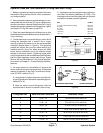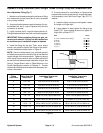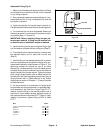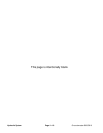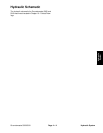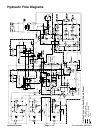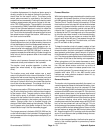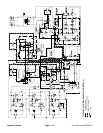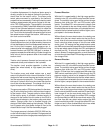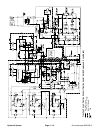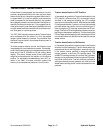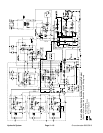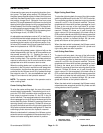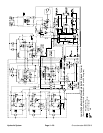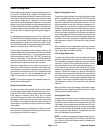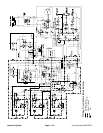
Groundsmaster 5900/5910 Hydraulic SystemPage 4 -- 15
Traction Circuit: High Speed
A variable displacement, bi--directional piston pump is
directly coupled to the engine flywheel to provide hy-
draulic flow for the traction circuit. The piston pump
swash plate movement is controlled by an electronic
proportional servo assembly. Pushingthe traction pedal
rotates a potentiometer that sends a signal to the ma-
chine TEC--5002 controller. The controller in turn sends
a corresponding PWM (Pulse Width Modulation) output
signal to the hydrostat electronic control to rotate the
pumpswashplateaccordinglytocontrolthepump’s out-
put. The oilfrom the hydrostat is directed to the frontand
rear wheel motors through the traction, 4WD and trac-
tion flush control manifolds.
Operating pressure on the high pressure side of the
closed loop traction circuit is determined by the amount
of load developed at the fixed displacement wheel mo-
tors. As the load increases, circuit pressure can in-
crease to relief valve settings: 4330 PSI (299 bar) in the
forward direction and 5330 PSI (368 bar) in reverse. If
pressure exceeds the relief setting, oil flows through the
relief valve to the low pressure side of the closed loop
traction circuit.
Traction circuit pressure (forward and reverse) can be
measured at test ports located on the hydrostat.
The traction circuit provides operation in either low
speed (four wheel assist) or high speed (two wheel
drive).
The traction pump and wheel motors use a small
amount of hydraulic fluid for internal lubrication. Fluid is
designed to leak across the pump and motor parts and
into the component case drain. This leakage results in
the loss of hydraulic fluid from the closed loop traction
circuit that must be replaced. The charge circuit is de-
signed to replace this traction circuit leakage.
The gear pump section (P3) that supplies oil to the steer-
ing, lift and cooling fan circuits, also provides charge oil
for the traction circuit. The gear pump is driven directly
off the traction pump. It provides a constant supply of
charge oil to the traction circuit to make up for oil that is
lost to internal leakage in the traction pump and wheel
motors. Charge pump flow is directed through the
charge oil filter before entering the hydrostat. This filter
has a bypass valve that allows charge oil flow to the
closed traction loop if the filter becomes plugged.
The charge pressure is limited to 330 PSI (22.8 bar) by
a relief valve located in the hydrostat. Charge pressure
can be measured at the charge pressure testport on the
hydrostat.
Forward Direction
With the Hi--Lo speed switch in the high range position,
solenoid valve (S) in the 4WD control manifold is ener-
gized. The solenoid valve spool shifts to direct charge
pressure that shifts the PD1 and PD2 control valve
spools. The shifted PD1 valve prevents hydraulic flow
from the hydrostat to the rear wheel motors. With flow
blocked to the rear wheel motors, all hydrostat flow is di-
rected to the front wheel motors to allow a higher, trans-
port speed in the forward direction.
Without flow to the rear wheel motors, the rotating rear
wheels drive the rear wheel motors so they act like a
pump. Inlet oil to the rear wheel motors is provided by a
check valve that allows charge oil into the rear wheel
motor circuit. Oil leaving the rear wheel motors enters
the 4WD control manifold atportM2andisdirectedback
to the rear wheel motors through the PD1 cartridge and
manifold port M1. To allow for rear wheel loop cooling
when in forward Transport operation, a small amount of
oil exits through the shifted PD2 cartridge and returns to
the charge circuit.
Reverse Direction
With the Hi--Lo speed switch in the high range position,
solenoid valve (S) in the 4WD control manifold is ener-
gized. The solenoid valve spool shifts to direct charge
pressure that shifts the PD1 and PD2 control valve
spools. Oil flow from the hydrostat port MA enters the
4WD control manifold at port P2, flows through the PR
pressure reducing valve and is stopped at the shifted
PD2 valve. With flow blocked to the rear wheel motors,
all hydrostat flow is directed to the front wheel motors to
allow a higher, transport speed in the reverse direction.
Without flow to the rear wheel motors, the rotating rear
wheels drive the rear wheel motors so they act like a
pump. Inlet oil to the rear wheel motors is provided by a
check valve at the 4WD control manifold CH port that al-
lows charge oil into the rear wheel motor circuit. This
charge oil is routed through the shifted PD2 cartridge
and out manifold port M2 to the rear wheel motors. Re-
turn flow from the rear wheel motors enters the 4WD
control manifold at port M1, through the shifted PD1car-
tridge and and is then directed back to the rear wheel
motors as they turn in the reverse direction.
Hydraulic
System



